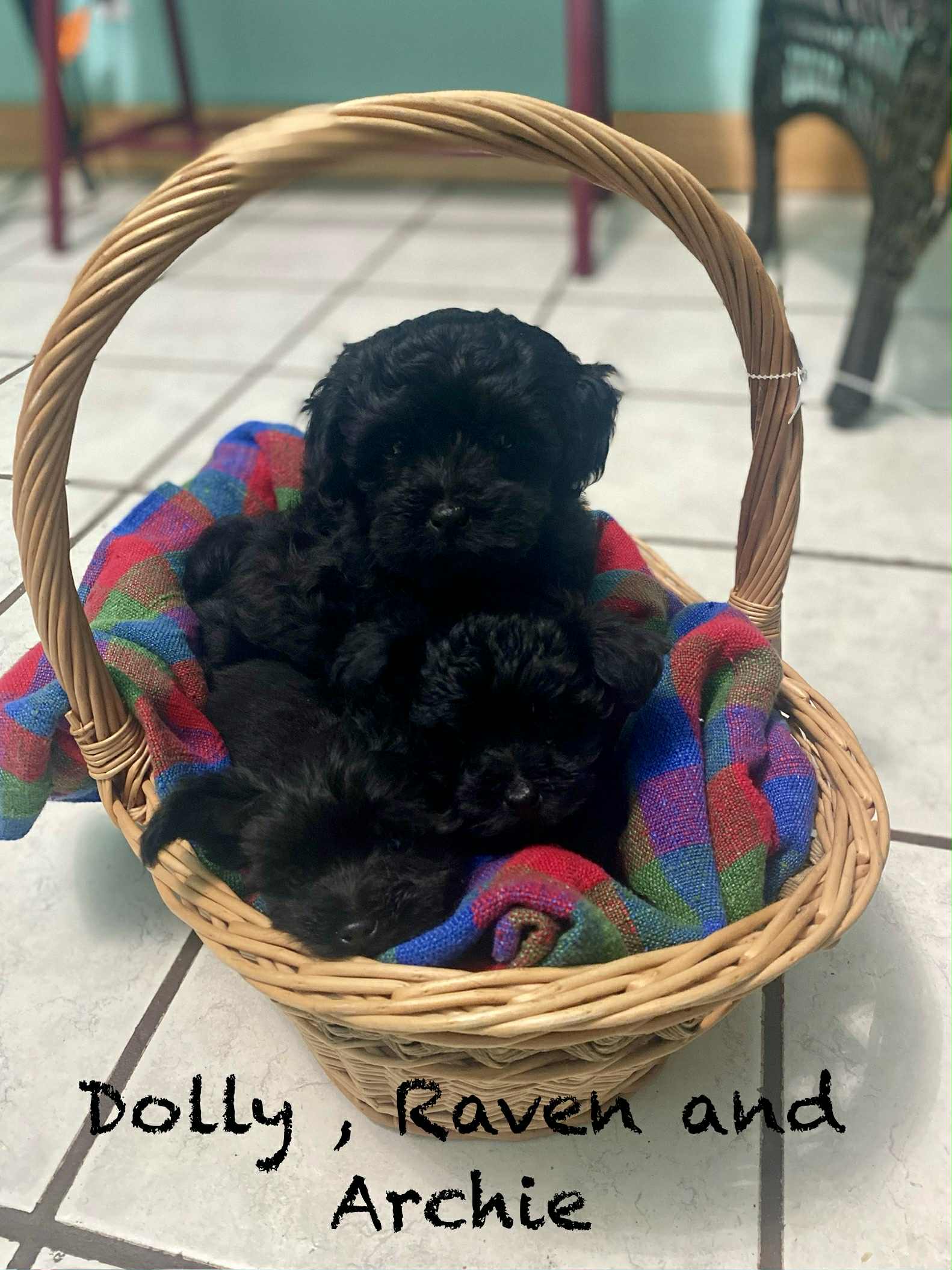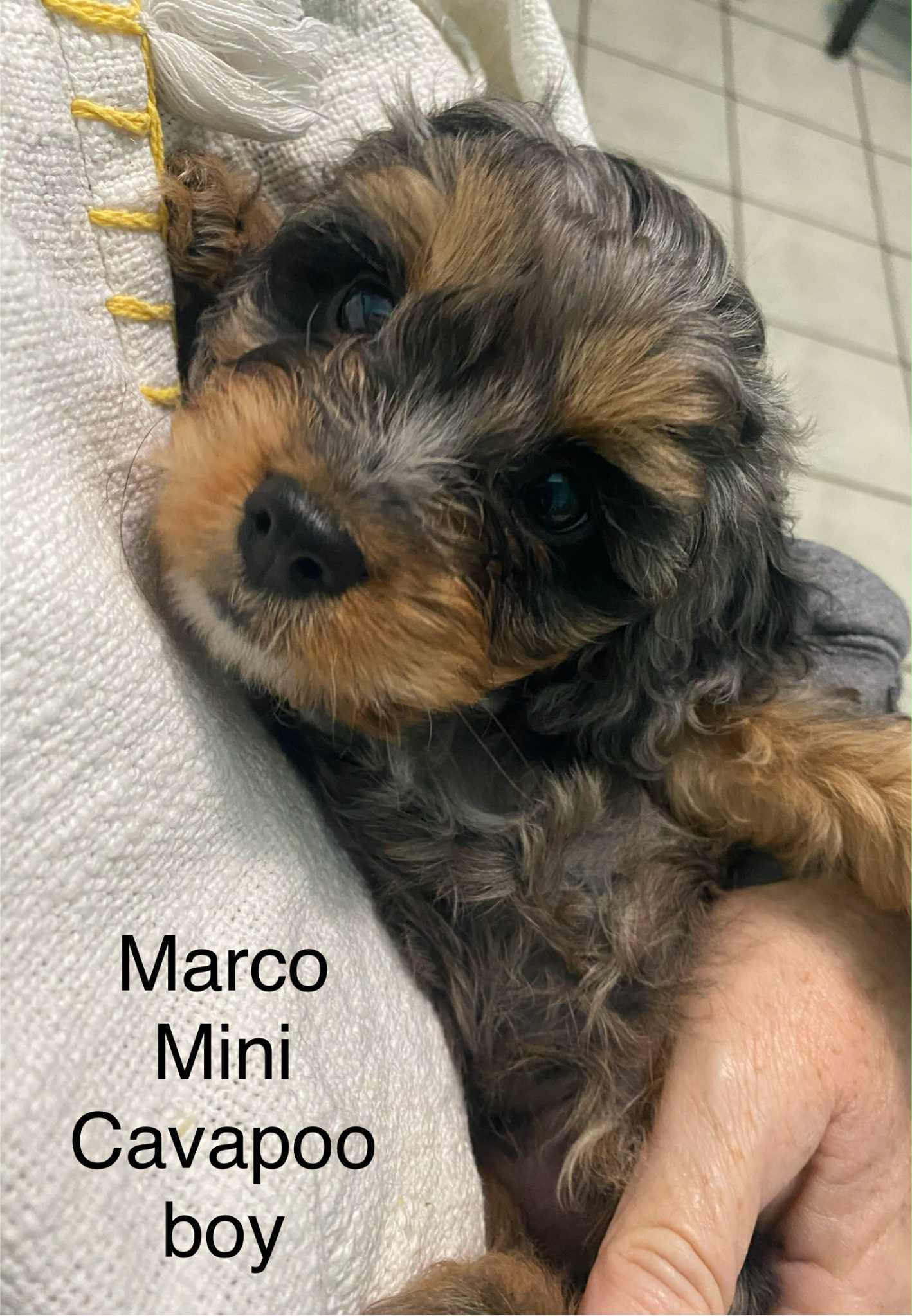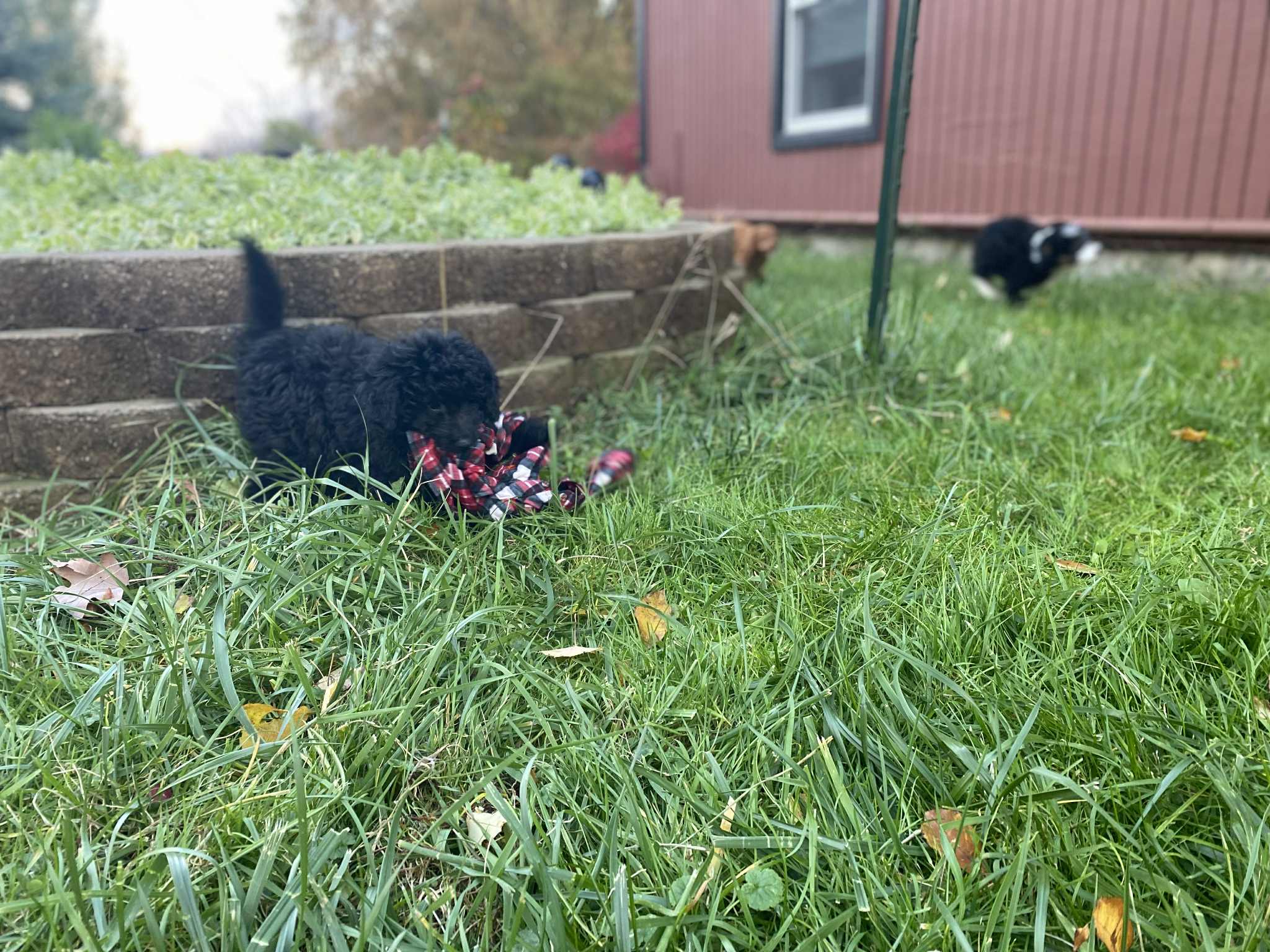Currently Available Puppies
Paypal to OrchardPups ~ Please click link to send money safe with Paypal ~ thank you!

Mini Poodles Baa Baa Black Sheep $850 Born 9/6 READY NOW!
Mini Poodles Baa Baa Black Sheep $1150 with $300 due now to reserve Born 9/6Ready to go home goal 11/1 *based on vet exam and weight . Mom Jewels & Dad Kristin 9/12 lbs weight goal .These sweet poodles are developing into stunning regal black diamonds. They will have an enduring nature , loving affectionate […]

Cavapoo Boos Pumpkin Patch Puppies Born 8/29 Ready goal after vet apt 10/24 $1300 with $300 due to reserve
Cavapoo BoosPumpkin Patch PuppiesBorn 8/29Ready goal after vet apt 10/24$1300 with $300 due to reserve These babies will have loose / wavy Teddybear coats . They are a great choice for first time pet families . The Cavapoo is happy and easy going . We will give you a supply list and training materials. I […]

Snuggle Bears F1BB Mini Goldendoodles $1950 Born on August 12, Ready Now!
F1BB Mini Goldendoodle$1950with $500 due to reserve Born on August 12, Ready goal 10/3 wonderful genetic tested parents: Jingles 20-pound F1B Mini Goldendoodle, and Blazer, a 15-pound Mini Poodle.These pups will have a sweet personality , round chubby pup with curly – wavy coats . We work with them daily using Early Neurological Stimulation (ENS) […]
The Nursery

Best Boy Ever! $1950 with $300 due to reserve F1B Standard Goldendoodle boy BUDDY! Born 9/24/25 call
Best Boy Ever! $1950 with $300 due to reserve F1B Standard Goldendoodle boy BUDDY!Born 9/24/25Ready goal 11/21/2025Mom f1 standard Goldendoodle Victoria Dad Standard Poodle Milo Weight goal 55/60 lbs Buddy is the most sweet boy you will ever meet . He is easy going , snuggly, and very smart . I truly see the potential […]

Holiday Teddybears ! Mini Bernadoodles $1050 Deposit due now $300. Balance due when you meet the puppy at eight weeks old – Born 9/27/25 Ready to go home goal 11/25/25, 4 boys and 2 girls
Holiday Teddybears !Mini Bernadoodles $1050Deposit due now $300. Balance due when you meet the puppy at eight weeks old Born 9/27/25Ready to go home goal 11/25/254 boys and 2 girls Quiet calmer nature , loves to snuggle and be close to you . They are known for being eager to please and easy to train, […]

The Night Before Christmas, $1950 with $300 due now to reserve, F1B Mini Goldendoodles, Born 10/23/25, Ready goal 12/18/25
Buzz Comet Dasher Ginger Johnny Lolly Suzie The Night Before Christmas $1950 with $300 due now to reserve F1B Mini Goldendoodles Born 10/23/25Ready goal 12/18/25Mom f1 Mini Goldendoodle Jasmine. 20 lbsDad Mini Poodle Willie 18 lbs Intelligent and Easy to Train: Inheriting intelligence from both the Golden Retriever and the Poodle, they are quick learners […]

Weeee Willie! Mini F1B Goldendoodle boy Born 9/10/25 Ready goal 11/10
Weeee Willie!Mini F1B Goldendoodle boy Born 9/10/25Ready goal 11/10/25$1800 with $300 due to reserve Mom Shirleu f1 mini Goldendoodle 20Dad Willie mini poodle 18lbs Facial furnishings are starting to show. This is a trait for Lower shedding perditions. They will be joyful and a dream for first time pet families . We will provide you […]

Reserve Call 316-576-1245 Cocoa Wishes – F1B Mini Goldendoodle Pups $1950 with $300 due now to reserve 🈯️Ready goal 12/17
Bernie Cricket Jack Tiny Tim Cocoa Wishes Mini Goldendoodle Puppies F1B$1950 with $300 due now to reserve Born 10/14Ready goal 12/17Delay pick up additional feeMom F1 mini Goldendoodle Judy 30lbsDad Mini Poodle Willie 18 lbs Puppy final weight goal 25/30 lbs Affectionate and Loving: They are known to be deeply devoted and affectionate, often craving […]

Wanna Build a SnowMan? F1BB mini Goldendoodle Puppies
Born 10/16Ready goal 12/11$1950 with $300 due to reserve *delay pick up addition fee Mom Thistle F1B mini Goldendoodle 27 lbsDad Willie Mini Poodle 18 lbs Puppy final weight goal 20/25 lbs Ultimate Cuddle Bugs: They are famous for being highly affectionate dogs who absolutely love to snuggle. They thrive on physical contact and will […]
Smaller Pups May be the Way to Go!
Our pups are all raised in a home environment and socialized with each other, adults, and children. We offer a wide variety of pups, and every one is sweet, loving, and family-friendly.
Please check back often to see pups in the nursery that you can reserve, or to see our pups available to adopt today!
NY STATE TAX COLLECTED ON ALL SALES – ALL PUPPY WEIGHTS ARE APPROXIMATE AND THEIR FUTURE GROWTH OR LACK OF GROWTH CAN NO WAY BE GUARANTEED – UPON YOUR REQUEST I CAN PROVIDE PICTURES OF ALL PUPS MOTHER AND FATHER AND POSSIBLE OLDER SISTERS & BROTHERS!
Orchard Pups is not responsible for any cost due to Hypoglycemia in your puppy after you leave the Orchard ~ Please read and ask questions to us or your Vet.
Hypoglycemia Requires Quick Intervention in Toy and Small Breeds
Signs of Hypoglycemia
- Loss of appetite
- Extreme lethargy
- Lack of coordination
- Trembling
- Muscular twitching
- Weakness
- Seizures
- Unusual behavior
- Dilated pupils
- Stupor or coma
Hypoglycemia, or low blood sugar, can quickly become an urgent health problem in toy and small-breed dogs, say experts. Without intervention, there is risk of dogs slipping into a coma and possibly dying.
Juvenile hypoglycemia, which is seen in puppies less than 3 months of age, generally occurs because puppies have not fully developed the ability to regulate blood glucose concentration and have a high requirement for glucose.
Understanding Hypoglycemia
“In a nutshell, the brain can only use glucose for energy,” explains Margret Casal, D.V.M., Ph.D., assistant professor of medical genetics at the University of Pennsylvania School of Veterinary Medicine. “If glucose levels drop in the blood, then there is less energy for the brain, which causes neurological signs such as disorientation, tremors and coma.
“Normally, glucose is stored in the form of glycogen in the body, and when necessary, hormones stimulate the breakdown of glycogen to supply the brain and other tissues with fuel,” she continues. “Sometimes in toy and small breeds, the process does not occur quickly enough and hypoglycemia begins to kick in.
“An animal that goes a prolonged period without glucose may eventually slip into a coma and possibly die. In toy and small-breed dogs that timeframe is greatly reduced when compared to larger dogs.”
Among the signs of hypoglycemia are loss of appetite, extreme lethargy, lack of coordination, trembling, muscle twitching, weakness, seizures, and discoloration of skin and gums.
“They usually act like they are drunk,” says Amirov. “They may be lethargic, shivering or refusing to get up and play. Most won’t eat or drink. If you know your puppies well and they are acting out of the ordinary, there’s a very good chance they are going into low sugar shock. A simple case of hypoglycemia is often due to overactivity combined with too much time between meals.
“After a dog has crashed due to hypoglycemia, I follow up with a protein-rich food, such as canned puppy food, to help stabilize the blood sugar and prevent another crash,” she continues. “If a dog doesn’t stabilize and continues to have difficulty after being given glucose, then I take him to the veterinarian. However, during a hypoglycemic attack, time is of the essence.”
Experts recommend rubbing syrup on a dog’s gums, dabbing sugar water on or under the tongue, or giving a concentrated solution of glucose to offset the drop in blood glucose. Providing a simple sugar solution and hydrating liquid are key.
“It also is imperative to keep them warm,” Smolarz says. “I put a kitchen towel in the microwave for 30 seconds. I shake it out and wrap the puppy in it to bring up his body temperature. Low blood sugar can cause hypothermia, so I get them warm first.
“Next, I give the puppy a teaspoon of honey and wait a few minutes. If the puppy seems to be getting better, I follow up by giving small amounts of warm sugar water over the next few minutes.”
Measures to prevent hypoglycemia include feeding puppies and small dogs three or four times a day. A high-quality, nutritious dog food is important in helping to sustain a dog. Owners also should provide a warm environment.
Smolarz crates puppies and adult dogs when they are fed to ensure they eat. “This also helps to prevent the litter bully from stealing everybody else’s food. When they are that small, you have to be sure they have enough to eat. I make sure they have kibble to eat freely, and I feed puppies three to four meals a day until they are 5 months old.”
